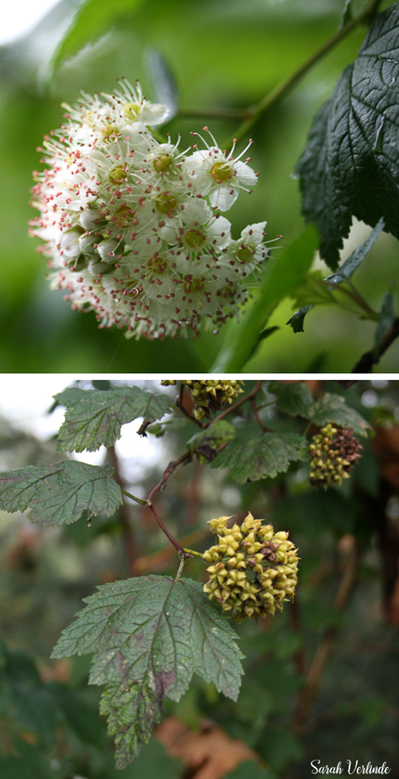Pacific ninebark
Physocarpus capitatus – Pacific ninebark
Morphology

- Family: Rosaceae
- Plant Type: deciduous upright/spreading shrub
- Height: 6-12 feet tall
- Leaves: lobed, double toothed margin, that are deeply veined, and dark, shiny green on top. They look like a maple or grape leaf. Alternately arranged.
- Notable feature: Bark is reddish-gray and papery, peeling off in thin layers.
Distribution and Habitat
Habitat: Riparian zones where a river or stream is nearby for adequate moisture or wetlands. Sunny to part-shade.
Pacific Ninebark, Physocarpus capitatus, is a lovely lowland Pacific Northwest deciduous shrub that does well in riparian (near rivers/creek) and wetland environments. It is native to the west coast, from Alaska to California, and east into Idaho. In Washington State, it is more common on the west side of the Cascade Mountains, but can be found along the Columbia and Snake Rivers in eastern Washington.
Reproduction
- Flower color: creamy white with pink stamens in a round floral cluster
- Flowering Season: April-July
- Generation: Perennial
Restoration/Conservation
The shrub form grows many dense stems together making a great place for birds to nest and provide shade and cover for small animals. Some large animals will graze on the foliage, like elk, deer, and bear, but it is less appetizing than other plants. Birds eat the seeds, which persist in the seed heads into winter
Pacific Ninebark is a logical plant to consider when planning a restoration project. This plant grows well from seed, hardwood cuttings, and live staking. This is a great plant to consider planting along stream banks to prevent erosion and provide stabilization because its fibrous roots hold the soil well. It tolerates full sun so no canopy for shade is needed overhead. Waiting too long, or planting late in phase-restoration, might result in too much shade, and the plant might not germinate or do well under a forest canopy of mature coniferous. This plant grows aggressively (American beauties 2014) which is another reason to plant in disturbed, or newly restored habitats. It could have the potential to shade out invasive species like reed canarygrass and Himalayan blackberry.
Ethnobotany
Native American tribes made children’s hunting bows, needles, and small items from the wood of Pacific ninebark. The straighter shoots were then used to make arrows. The stems of the plant, without the bark, were used as tea or medicine to be used as a laxative or to treat gonorrhea or sores. The bark is poisonous but was used in a tea in small amounts to induce vomiting. The bark was often mixed with cedar bark to make a dark brown dye.
References and Resources:
- WTU Image Herbarium: http://biology.burke.washington.edu/herbarium/imagecollection/taxon.php?Taxon=Physocarpus%20capitatus
- Merriam, CH. 1966. Ethnographic notes on California Indian Tribes. Berkeley (CA): University of California Archaeological Research Facility (p. 264).
- Pojar, J and MacKinnon, A. 2004. Plants of the Pacific Northwest Coast: Washington, Oregon, British Columbia and Alaska. Vancouver (BC): Lone Pine Publishing.
- Turner, NJ and Efrat, BS. 1982 Ethnobotany of the Hesquiat Indians of Vancouver Island. Victoria (BC): British Columbia Provincial Museum (p. 73).
- USDA: Plant characteristics [Internet]. c2019 [cited 2019 Aug 30]. Available from: https://plants.usda.gov/core/profile?symbol=PHCA11
- USDA: Plant Fact Sheet – Pacific Ninebark [Internet]. c2019 [cited 2019 Aug 30]. Available from: https://plants.usda.gov/factsheet/pdf/fs_phca11.pdf
This article was written by Sarah Verlinde. For questions regarding the UWB/CC Plant Tour, contact Sarah at severlin@uw.edu.
